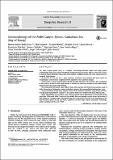Por favor, use este identificador para citar o enlazar a este item:
http://hdl.handle.net/10261/319903COMPARTIR / EXPORTAR:
 SHARE SHARE
 CORE
BASE CORE
BASE
|
|
| Visualizar otros formatos: MARC | Dublin Core | RDF | ORE | MODS | METS | DIDL | DATACITE | |

| Título: | Geomorphology of the Avilés Canyon System, Cantabrian Sea (BayofBiscay) |
Autor: | Gómez-Ballesteros, María; Druet Vélez, María CSIC ORCID; Muñoz, A. CSIC; Arrese-González, Beatriz; Rivera, Jesús; Sánchez-Delgado, Francisco; Cristobo, Javier; Parra-Descalzo, Santiago; García-Alegre, Ana; González-Pola, César; Gallastegui, J.; Acosta-Yepes, Juan | Palabras clave: | Medio Marino Aviles Canyon System Sede Central IEO La Gaviera and El Corbiro Geomorphology Cantabrian Margin (Bay of Biscay) Multibeam bathymetry Sediment transport. |
Fecha de publicación: | 2014 | Citación: | Deep Sea Research II, 106. 2014: 99-117 | Resumen: | The Avilés Canyon System (ACS) is a complex, structurally-controlled canyon and valley system constituted by three main canyons of different morphostructural character. They are, from east to west: La Gaviera Canyon, El Corbiro Canyon and Avilés Canyon. In addition to this ACS, a new canyon has been surveyed: Navia Canyon. We present for the first time a high resolution multibeam map showing with great detail the morphological and structural complexity of this segment of the Cantabrian margin. ACS presents a tectonic imprint marked by NW-SE, NNE-SSW and E-W structures. The morphology of their reaches as well as their single mouth, in addition to some rock dredges in their major valleys, demonstrates active down-slope flushing. The continental shelf shows a flat, uniform slope with local and well defined rock outcrops south of Aviles Canyon head. Sedimentary zones are limited, showing thin unconsolidated sedimentary cover. Strong continental margin water dynamics avoid thicker sediment deposition, being littoral sedimentary dynamics responsible for transport to the canyons heads and conduit to the Biscay Abyssal plain. Biscay Abyssal Plain shows evidence of a strong westward current affecting the surveyed strip of this more than 10 km wide plain. Presence of two parallel deep sea channels, erosive scarps, and erosion of gully divides on the lower slope, may indicate that this is part of the distal fan at the termination of the large turbiditic system fed by Cap Ferret, Capbreton and other large canyons (Santander, Torrelavega, Lastres and Llanes) to the west of ACS. | Versión del editor: | http://www.sciencedirect.com/science/article/pii/S096706451300372X | URI: | http://hdl.handle.net/10261/319903 | DOI: | 10.1016/j.dsr2.2013.09.031 | ISSN: | 0967-0645 |
| Aparece en las colecciones: | (IEO) Artículos |
Ficheros en este ítem:
| Fichero | Descripción | Tamaño | Formato | |
|---|---|---|---|---|
| Gomez Ballesteros, et al 2014_Abstract.pdf | 60,57 kB | Adobe PDF |  Visualizar/Abrir |
CORE Recommender
SCOPUSTM
Citations
33
checked on 07-may-2024
WEB OF SCIENCETM
Citations
29
checked on 28-feb-2024
Page view(s)
22
checked on 07-may-2024
Download(s)
11
checked on 07-may-2024
Google ScholarTM
Check
Altmetric
Altmetric
Este item está licenciado bajo una Licencia Creative Commons

